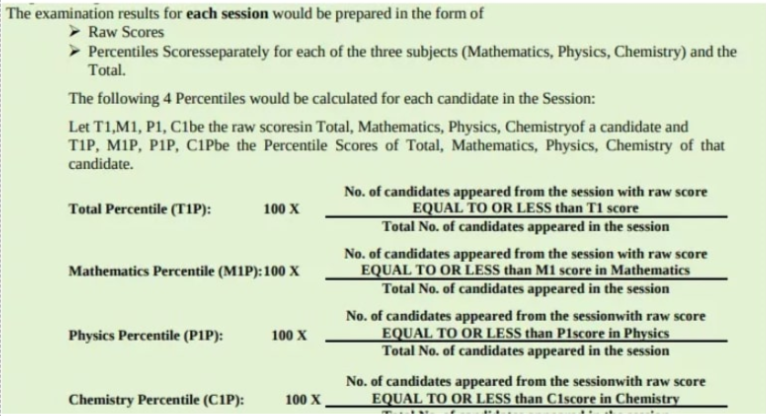
How to Calculate Percentile in JEE : The Joint Entrance Examination (JEE) is a crucial step for aspiring engineers in India, and understanding the concept of percentile is paramount for success. In this blog, we’ll talk about how to calculate percentile in JEE , percentile to rank, marks to percentile conversion, normalization procedure, tie-breaker rule, and more.
How To Calculate Percentile In JEE?
How To Calculate Percentile In JEE? : Learning to calculate percentile in JEE is fundamental for any aspiring engineer. The percentile, a statistical measure indicating the percentage of candidates who scored equal to or below a particular rank, plays a pivotal role in the evaluation process. Here’s the detailed procedure on how to calculate percentile in JEE .1. Determine Your Raw Score
Begin by identifying your raw score in the JEE examination 2024 . Your raw score represents the total number of correct answers, and it serves as the starting point for percentile calculation.2. Understand The Percentile Calculation Formula :
Percentile Calculation Formula : The percentile calculation formula involves two essential components: the number of candidates who scored lower than you and the total number of candidates who took the exam. The formula is expressed as follows: This formula establishes the proportion of candidates who performed less well than you and converts it into a percentile ranking.
This formula establishes the proportion of candidates who performed less well than you and converts it into a percentile ranking.
3. Convert Raw Score To Percentile
Use the obtained information to apply the percentile formula and calculate your percentile. This percentile is a crucial indicator of your relative performance compared to other candidates.4. Understand Percentile Ranking
Percentile ranking provides a clear picture of where you stand in comparison to your peers. For instance, if your percentile is 90, it signifies that you performed as well as or better than 90% of the total candidates who appeared for the examination.5. Interpret Your Percentile
A higher percentile is indicative of a better rank. Understanding your percentile is crucial for gauging your performance and setting realistic expectations for your JEE Main rank.6. Utilize Percentile For Decision Making
As you receive your percentile, use it as a valuable tool for making informed decisions during the counselling and admission process. Your percentile is a key factor considered by colleges during the admission procedure.7. Keep Abreast Of Percentile Cutoffs
Different colleges may have specific percentile cutoffs for admission. Stay updated with the cutoffs of the institutes you are interested in to gauge your eligibility and make well-informed decisions.8. Leverage Percentile Analysis Tools
Online platforms often provide percentile analysis tools that allow you to compare your performance with that of other candidates. These tools can offer insights into your standing and help you strategize accordingly.Normalization Procedure in JEE Mains
The normalization procedure in JEE Main aims to ensure a fair evaluation process, especially when the examination is conducted in multiple sessions. It accounts for variations in the difficulty levels of different sets of question papers.- What Is It? : Normalization involves adjusting the scores of candidates to account for differences in the difficulty level of various sessions.
- Factors Influencing Normalization : The normalization process considers factors such as the average performance of candidates in each session, the standard deviation of scores, and the percentile score.
- Importance of Normalization : Normalization is crucial for providing a level playing field, ensuring that candidates are not disadvantaged due to the luck of the draw in terms of question paper difficulty.
JEE Mains Tie Breaker Rule
In scenarios where two or more candidates secure the same rank, the tie-breaker rule comes into play.- Parameters for Tie-Breaking: The tie-breaker rule considers factors such as the candidate with higher marks in Mathematics, followed by Physics and Chemistry, and finally, the age of the candidate.
- Fairness in Tie-Breaking: The tie-breaker rule is in place to ensure a fair and transparent method for ranking candidates with similar scores.
Preparation Of JEE Main Results
The process of preparing JEE Main results involves meticulous planning and adherence to established norms.- Compilation of Raw Scores: Raw scores of candidates from different sessions are collected and analysed.
- Application of Normalisation Factors: Normalization factors are applied to ensure fairness in comparing scores from different sessions.
- Ranking and Result Declaration: Once the normalisation process is complete, candidates are ranked based on their normalised scores, and results are declared.
How To Convert Percentile To Rank?
So, to convert your JEE Main Percentile to a Rank, you will need the following figures:- Your NTA Normalized score
- The total number of applicants who attempted the exam
- Percentage of students with grades lower than or equal to yours
- Percentage of applicants who scored higher than you
- Number of students who scored higher than you
| How To Convert Percentile To Rank? | |
| Your NTA Percentile score | P |
| Total number of applicants | N |
| Percentage of applicants below or equal to your marks | P For example, if you received a 70%ile in JEE Main, this means that 70% of the applicants who took JEE Main scored lower at the same level as you. |
| Percentage of applicants scoring higher than you | 100 – P |
| JEE Main Rank (Number of applicants who scored higher than you) | {(100 – P)/100}*N |
How To Calculate Marks From Percentile In JEE?
Understanding how to estimate your JEE Main marks based on your percentile is a valuable skill that can provide deeper insights into your performance and aid in setting realistic goals. While the exact marks corresponding to a percentile can vary based on the total number of candidates and the difficulty level of the paper, there are general guidelines to help you make a rough estimate.Find Out Your Total Marks
Start by knowing the total marks for the JEE Main examination. This information is crucial for converting percentiles into an estimated range of marks.Use Percentile-To-Marks Conversion Tables
Exam authorities often provide percentile-to-marks conversion tables. These tables help candidates get an idea of the approximate marks corresponding to their achieved percentile. These tables are compiled based on statistical analysis of past years' data and can provide a reasonable estimate. For example, if your percentile falls within the 90-95% range, the corresponding marks might be in a certain range. However, keep in mind that these tables are indicative and may not be entirely accurate due to variations in the difficulty level of different exam sessions.Consider Normalization
In cases where the JEE Main examination is conducted in multiple sessions, the normalisation process may come into play. Normalisation adjusts scores to account for differences in the difficulty levels of various sets of question papers. It's important to consider normalisation factors when estimating your marks. For instance, if you appeared for a session with a more challenging paper, the normalisation process may positively impact your percentile, leading to a higher estimated range of marks.Negative Marking In JEE Main
JEE Main follows a negative marking scheme, where incorrect answers result in a deduction of marks. While calculating your estimated marks, be sure to account for negative marking. This ensures a more accurate reflection of your performance.Use Online Calculators and Predictors
Online platforms and websites often provide tools and calculators that claim to predict JEE Main marks based on your percentile. While these tools can give you a quick estimate, it's crucial to approach them with caution. They may not always consider all the variables involved, and the accuracy of predictions may vary.Verify with Official Information
While estimates and predictions are helpful, it's crucial to rely on official information provided by the exam authorities. The official percentile to marks conversion tables, when available, should be considered the most reliable source for understanding your expected marks.Understanding How To Calculate Percentile In JEE
Understanding how to calculate percentile in JEE, its significance in JEE Main 2024, and the intricacies of normalisation procedures is crucial for aspirants. A transparent grasp of these concepts empowers candidates to make informed decisions, set realistic expectations, and navigate the admission process with confidence. Stay updated with official announcements, leverage online tools for predictions, and most importantly, focus on consistent and dedicated preparation to ace the JEE Main examination.How To Calculate Percentile In JEE FAQs
Q.1: Can I calculate my JEE Main percentile without knowing the total number of candidates?
Ans. No, the percentile calculation requires knowledge of the total number of candidates to determine your relative standing.
Q.2: How often does JEE Main undergo changes in its examination pattern?
Ans. Changes in the JEE Main examination pattern can occur, so it's essential to stay updated with official announcements for the latest information.
Q.3: Is there a direct correlation between JEE Main percentile and rank?
Ans. Yes, a higher percentile generally corresponds to a better rank, but understanding the distribution of scores is crucial for a more accurate interpretation.
Q.4: What role does the tie-breaker rule play in JEE Main rankings?
Ans. The tie-breaker rule is invoked when candidates secure the same rank, prioritising subject-specific scores and age to determine the final ranking.
Q.5: Can I estimate my JEE Main marks using only my percentile?
Ans. While you can estimate your marks from percentile using conversion tables, it's advisable to consider normalisation factors for a more accurate prediction.
Talk to a counsellorHave doubts? Our support team will be happy to assist you!

Check out these Related Articles
Free Learning Resources
PW Books
Notes (Class 10-12)
PW Study Materials
Notes (Class 6-9)
Ncert Solutions
Govt Exams
Class 6th to 12th Online Courses
Govt Job Exams Courses
UPSC Coaching
Defence Exam Coaching
Gate Exam Coaching
Other Exams
Know about Physics Wallah
Physics Wallah is an Indian edtech platform that provides accessible & comprehensive learning experiences to students from Class 6th to postgraduate level. We also provide extensive NCERT solutions, sample paper, NEET, JEE Mains, BITSAT previous year papers & more such resources to students. Physics Wallah also caters to over 3.5 million registered students and over 78 lakh+ Youtube subscribers with 4.8 rating on its app.
We Stand Out because
We provide students with intensive courses with India’s qualified & experienced faculties & mentors. PW strives to make the learning experience comprehensive and accessible for students of all sections of society. We believe in empowering every single student who couldn't dream of a good career in engineering and medical field earlier.
Our Key Focus Areas
Physics Wallah's main focus is to make the learning experience as economical as possible for all students. With our affordable courses like Lakshya, Udaan and Arjuna and many others, we have been able to provide a platform for lakhs of aspirants. From providing Chemistry, Maths, Physics formula to giving e-books of eminent authors like RD Sharma, RS Aggarwal and Lakhmir Singh, PW focuses on every single student's need for preparation.
What Makes Us Different
Physics Wallah strives to develop a comprehensive pedagogical structure for students, where they get a state-of-the-art learning experience with study material and resources. Apart from catering students preparing for JEE Mains and NEET, PW also provides study material for each state board like Uttar Pradesh, Bihar, and others
Copyright © 2025 Physicswallah Limited All rights reserved.
Get App









